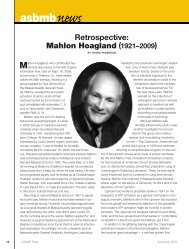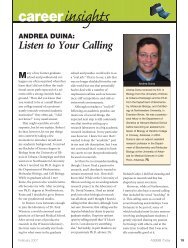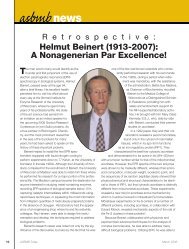View Program - asbmb
View Program - asbmb
View Program - asbmb
- TAGS
- program
- asbmb
- www.asbmb.org
Create successful ePaper yourself
Turn your PDF publications into a flip-book with our unique Google optimized e-Paper software.
59<br />
Glycolipid flip-flop across the ER during protein Nglycosylation<br />
Sumana Sanyal 1, 2 , Anant Menon 1 .<br />
Weill Cornell Medical College of Cornell University 1 , Whitehead Institute/MIT 2<br />
Abstract:<br />
N-glycosylation is an essential modification for most proteins entering the secretory pathway.<br />
The topological split in assembly of the core glycolipid donor (dolichol-PP-GlcNAc2Man9Glc3)<br />
required for N-glycosylation suggests that a key intermediate is translocated from the<br />
cytoplasmic to the lumenal face of the ER during this process. In addition lipid flip-flop is an<br />
essential step in transport of mannosyl phosphoryl dolichol (MPD), a glycolipid donor utilized in<br />
the ER lumen for a number of biosynthetic pathways. We reconstituted ATP-independent,<br />
protein-mediated, rapid transport of both the dolichol-linked oligosaccharide intermediate, dol-<br />
PP-GlcNAc2Man5 (M5-DLO) as well as MPD, in proteoliposomes generated from a Triton X-<br />
100 extract (TE) of rat-liver microsomes. The lectin Concanavalin A was used to probe the<br />
transbilayer distribution of M5-DLO in intact unilamellar vesicles, while MPD flipping was<br />
monitored through chemical oxidation of a full-length radiolabeled version of MPD. We<br />
resolved the ER resident M5-DLO and MPD flippase activities using traditional<br />
chromatographic separations and fractionated each to ~20-fold enrichment. Using an activity<br />
enriched fraction we showed that the M5-DLO flippase displays remarkable specificity in<br />
translocating intermediates of the N-glycosylation pathway. Specificity was defined by<br />
reconstituting lipid intermediates with varying glycan headgroups, including a structural isomer<br />
of M5-DLO (iM5-DLO). Kinetic analyses indicated that DLOs larger than M5-DLO are poorly<br />
translocated by the flippase; in addition, its structural isomer iM5-DLO was also transported<br />
~100 fold more slowly, suggesting that they are all suboptimal flippase substrates. Similarly,<br />
MPD flippase activity displayed a preference for the physiological substrate (β-MPD) over a<br />
non-natural substrate (α-MPD). Our results suggest a simple structural correlation for the<br />
interaction between ER flippases and their respective substrates.






